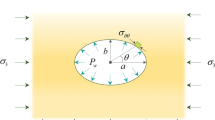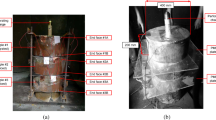Abstract
Stability analysis of elliptical shape perforations embedded in a compressive stress field is presented. The study is based on finite element analysis with an advanced material model capable of predicting surface buckling and localization of deformation in shear bands causing failure in a structure. The model is an extended flow theory of plasticity for a Mohr–Coulomb solid with Cosserat micro-structure. The application is related to the stability of perforation tunnels that are used for the flow of hydrocarbon in the wellbores. It is demonstrated that it is essential to carry out advanced localization analysis in order to reach correct results upon which a new perforation shape design can be based. Classical stress analysis predicts that an elliptical hole suffers less stress concentration than a circular hole when its major axis is aligned with the direction of the major principal stress and its axis ratio is the same as the applied stress ratio. However, failure analysis based on localization of deformation show that an elliptical hole will be stronger if its axis ratio is greater than the ratio of the applied stresses. Other practical applications can be found in the design of underground cavities in geotechnical, mining and petroleum engineering.
Similar content being viewed by others
Author information
Authors and Affiliations
Additional information
Received 2 August 1999
Rights and permissions
About this article
Cite this article
Papanastasiou, P. Localization of deformation and failure around elliptical perforations based on a polar continuum. Computational Mechanics 26, 352–361 (2000). https://doi.org/10.1007/s004660000183
Issue Date:
DOI: https://doi.org/10.1007/s004660000183




